Online meetings and remote access to enterprise resources - statistics
Data extracted in May 2023
Planned article update: May 2025
Highlights
During 2022, half of EU enterprises conducted online meetings.
During 2022, 77.7 % of EU enterprises gave their employees remote access to their e-mail systems.
During 2022, 65 % of EU enterprises gave their employees remote access to documents of the enterprise.
During 2022, 61.8 % of EU enterprises provided their employees with remote access to the business applications or software.
Enterprises conducting remote meetings via the internet, 2022
This article presents recent statistical data on enterprises conducting online meetings and providing remote access to enterprise resources (i.e. e-mail, documents, business applications or software) to its employees. For decades, the adoption of digital technologies by enterprises has been transforming the way they conduct their business. The recent experiences with the Covid-19 pandemic have highlighted more than ever the potential that digital technologies have for improving the economic resilience of businesses. The ever-increasing capabilities of ICT and a remote access to enterprise resources created a possibility for employees to continue performing their tasks and thus sustain the enterprise's activity.
Full article
Remote meetings via the internet
The Covid-19 pandemic has rapidly changed work models and has forced many enterprises to turn to virtual meetings in order to bridge the physical distance and maintain their businesses. In 2022, half of the EU enterprises (50 %) with 10 or more employees and self-employed persons conducted meetings via the internet, whereby there were significant differences depending on an enterprise’s size. The highest share of enterprises that conducted remote meetings was recorded among large enterprises (93 %), which was more than two times higher than for small enterprises (44 %) (Figure 1).
![]A vertical bar chart showing the share of enterprises in the EU conducting remote meetings via the internet by size class for the year 2022. Data are shown as percentage of enterprises for each size class.](/eurostat/statistics-explained/images/thumb/9/96/Enterprises_conducting_remote_meetings_via_the_internet_by_size_class%2C_EU%2C_2022_%28%25_of_enterprises%29.png/500px-Enterprises_conducting_remote_meetings_via_the_internet_by_size_class%2C_EU%2C_2022_%28%25_of_enterprises%29.png)
(% of enterprises)
Source: Eurostat (isoc_ci_mvis)
A comparison of EU countries (Figure 2) shows that the share of enterprises conducting remote meetings ranged between 79.4 % and 28.2 %. The highest share of enterprises conducting remote meetings was recorded in Sweden (79.4 %), followed by Finland (78.5 %) and Denmark (78.0 %), while the lowest shares were recorded in Bulgaria (28.2 %), Hungary (29.4 %) and Romania (31.2 %).
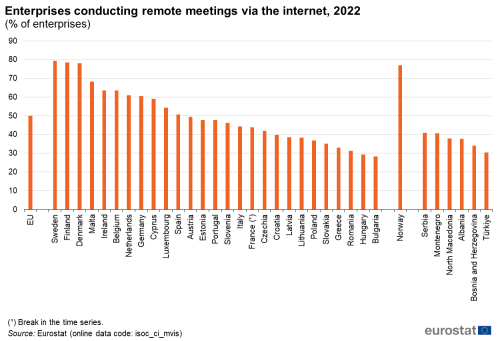
(% of enterprises)
Source: Eurostat (isoc_ci_mvis)
The share of enterprises conducting meetings via the internet varied depending on the branch of the economy in which they were operating and the nature of their work. As shown in Figure 3, enterprises in some economic activities conducted remote meetings much more than in others. In 2022, the information and communication sector (92.9 %), professional, scientific and technical activities (84.4 %) and electricity, gas, steam and air conditioning supply activities (82.1 %) stood out with the highest shares of enterprises that conducted remote meetings. The lowest shares were in accommodation and food service activities (22.2 %), construction (36.8 %) and transportation and storage (38.3 %).

(% of enterprises)
Source: Eurostat (isoc_ci_mvin2)
Remote meetings have many advantages, for instance they might reduce costs, reduce commuting time, among others. As shown in Figure 4, among EU enterprises conducting remote meetings in 2022, 44.2 % of enterprises had guidelines for recommending online meetings instead of physical meetings requiring travelling. The highest share of enterprises conducting remote meetings and having guidelines favouring remote meetings over business travel was recorded in Romania (70.0 %), followed by Cyprus (64.7 %) and Spain (64.2 %), while the lowest shares were recorded in Croatia (14.6 %), Czechia (24.7 %) and Germany (26.8 %).
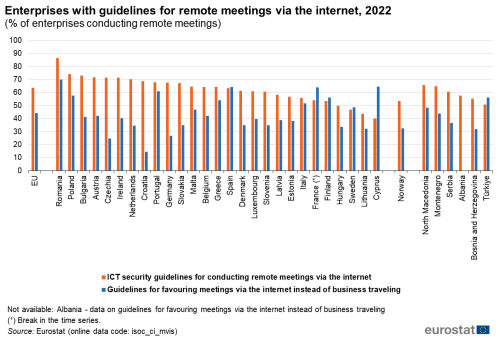
(% of enterprises conducting remote meetings)
Source: Eurostat (isoc_ci_mvis)
Despite significant advantages of remote meetings, they can become a security risk. Therefore, it is important that enterprises make their employees aware of ICT security related issues, for example with guidelines which may refer to particular requirements for passwords, end-to-end encryption, the use of specific tools allowed by the enterprise, the use of private or corporate devices or any other security related guidelines. As shown in Figure 4, among the EU enterprises conducting meetings via the internet, 63.7 % of them had ICT security guidelines describing the security measures for online meetings conducted by their employees. The highest share was recorded in Romania (86.4 %), followed by Poland (74.3 %) and Bulgaria (73.0 %), while the lowest shares were recorded in Cyprus (40.0 %), Lithuania (43.6 %) and Sweden (47.0 %).
Remote access to enterprise resources
Statistical data on remote access aims to measure the technological readiness of enterprises to make it possible for their employees to work remotely by giving them remote access to the enterprise resources (e.g. remote access to the e-mail system, to documents or to business applications or software of the enterprise). In 2022, 77.7 % of the EU enterprises with 10 or more employees or self-employed persons gave their employees remote access to the e-mail system, 65.0 % to the documents of the enterprise (e.g. files, spreadsheets, presentations, charts, photos) and 61.8 % to the business applications or software of the enterprise (e.g. access to accounting, sales, orders, CRM), see Figure 5.
Figure 5 shows that the situation differs when looking at the size of the enterprises. In particular, large enterprises more often provided their employees with remote access to the above-mentioned enterprise resources compared with small enterprises.
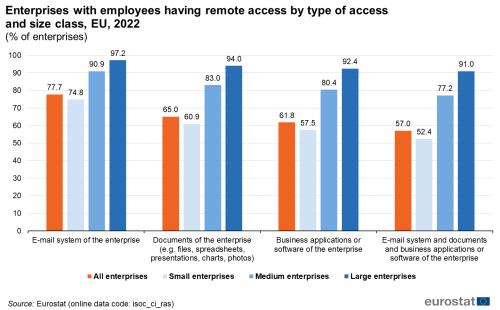
(% of enterprises)
Source: Eurostat (isoc_ci_ras)
In 2022, 57.0 % of EU enterprises offered all three types of remote access to their employees (i.e. to the email system, documents and business applications or software of the enterprise) (Figure 5). Comparison of EU countries shows that the share ranged between 79.0 % and 33.6 % among EU countries. The highest share of enterprises that provided all three types of remote access to their employees was recorded in Belgium (79.0 %), followed by Finland (78.2 %) and Croatia (75.4 %), while the lowest shares were recorded in Romania (33.6 %), Bulgaria (34.5 %) and Greece (35.7 %) (Figure 6).
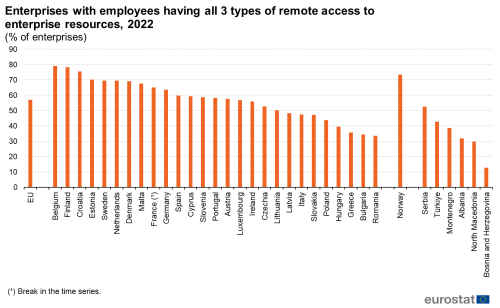
(% of enterprises)
Source: Eurostat (isoc_ci_ras)
The share of enterprises providing their employees with remote access to the enterprise resources depended on the branch of the economy in which they were operating. As shown in Figure 7, in some economic activities, many more enterprises provided their employees with remote accesses than in others, which is also connected to the nature of work, i.e. some activities could effectively be done remotely, while activities with a physical nature of work cannot be done remotely. Activities with the highest share of enterprises having remote access to their resources (e-mail system, documents and business applications or software) include the information and communication sector (87.8 %), followed by electricity, gas, steam and air conditioning supply activities (81.5 %) and professional, scientific and technical activities (81.0 %). The lowest share of enterprises with employed persons having such remote access was in accommodation and food service activities (36.8 %), transport and storage (48.4 %) and construction (48.6 %).

(% of enterprises)
Source: Eurostat (isoc_ci_ran2)
As shown in Figure 8, among the EU enterprises with at least one type of remote access for their employees (i.e. to the email system, documents or business applications or software of the enterprise), 65 % of them had ICT security guidelines describing the security measures for remote access to the enterprise resources. Such guidelines may refer to requirements for conducting password–secured remote meetings only, the prohibition of using public Wi-Fi for work, the use of VPN, requirements concerning privacy of data, etc. The cross-country comparison shows that, among enterprises with at least one of the different types of remote access for their employees, the highest share of enterprises with ICT guidelines for remote access was recorded in Czechia (84.2 %), followed by Austria (80.6 %) and the Netherlands (79.6 %), while the lowest shares were recorded in Cyprus (31.5 %), Lithuania (32.5 %) and Croatia (40.2 %).
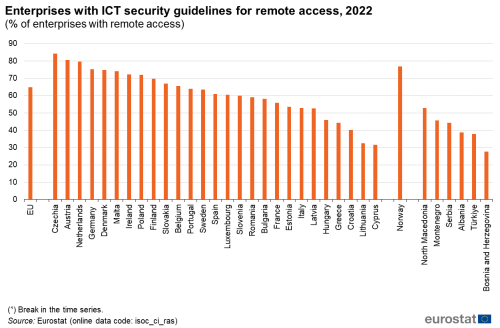
(% of enterprises with remote access)
Source: Eurostat (isoc_ci_ras)
Source data for tables and graphs
Data sources
Source: Data presented in this article are based on the results of the 2022 Community survey on 'ICT usage and e-commerce in enterprises'. Statistics were obtained from surveys in enterprises conducted by National Statistical Authorities in the first months of 2022.
Sample: In 2022, some 150 400 enterprises, with 10 or more employees or self-employed persons, out of 1.47 million in EU were surveyed. Out of these 1.47 million enterprises, approximately 83 % were small enterprises (with 10-49 employees or self-employed persons), 14 % medium (50-249 employees) and 3 % large enterprises (250 or more employees).
Main concepts: The observation statistical unit is the enterprise, as defined in the Regulation (EEC) No 696/1993 of 15 March 1993. The survey covered enterprises with at least 10 employees or self-employed persons. Economic activities correspond to the classification NACE Revision 2. The sectors covered are manufacturing, electricity, gas and steam, water supply, construction, wholesale and retail trades, repair of motor vehicles and motorcycles, transportation and storage, accommodation and food service activities, information and communication, real estate, professional, scientific and technical activities, administrative and support activities and repair of computers and communication equipment.
Context
Digitalisation and automation can generate new business opportunities through the development of new production processes, new products and new markets. Indeed, the impact of information and communication technologies within the workplace has generally resulted in increased productivity and efficiency, as well as a range of possibilities for more flexible working practices. Covid-19 had an impact on the adoption and the use of digital technologies as it required changes in the way businesses operate. Digital transformation is high on the European policy agenda, with making Europe fit for the digital age and empowering its citizens and businesses with a new generation of technologies being one of the main political priorities of the European Commission for the coming years. In 2021, the Digital Compass for the EU's Digital Decade (COM(2021)118 final), set the EU’s digital targets for 2030, evolving around four cardinal points: skills, digital transformation of businesses, secure and sustainable digital infrastructures, and digitalization of public services.
Direct access to
See also
- Impact of COVID-19 on the use of ICT in enterprises
- Impact of COVID-19 on e-sales of enterprises
- Digital economy and society statistics - enterprises
- Cloud computing - statistics on the use by enterprises
- ICT specialists - statistics on hard-to-fill vacancies in enterprises
- E-commerce statistics
- E-business integration
- ICT security in enterprises
- Social media - statistics on the use by enterprises
Main tables
Database
- ICT usage in enterprises (isoc_e)
- Connection to the internet (isoc_ci)
Dedicated section
Methodology
- ICT usage and e-commerce in enterprises (ESMS metadata file — isoc_e_esms)
Legislation
- Regulation (EU) 2019/2152 of the European Parliament and of the Council of 27 November 2019 on European business statistics
- Regulation (EC) No 808/2004 of the European Parliament and of the Council of 21 April 2004 concerning Community statistics on the information society
- Regulation (EC) No 960/2008 of 30 September 2008 implementing Regulation (EC) No 808/2004 concerning Community statistics on the information society
- Regulation (EC) No 1023/2009 of 29 October 2009 implementing Regulation (EC) No 808/2004 concerning Community statistics on the information society
- Regulation (EU) No 821/2010 of 17 September 2010 implementing Regulation (EC) No 808/2004 concerning Community statistics on the information society
- Regulation (EU) No 937/2011 of 21 September 2011 implementing Regulation (EC) No 808/2004 concerning Community statistics on the information society
- Regulation (EU) No 1083/2012 of 19 November 2012 implementing Regulation (EC) No 808/2004 concerning Community statistics on the information society
- Regulation (EU) No 859/2013 of 5 September 2013 implementing Regulation (EC) No 808/2004 concerning Community statistics on the information society
- Regulation (EU) No 1196/2014 of 30 October 2014 implementing Regulation (EC) No 808/2004 concerning Community statistics on the information society
- Regulation (EU) 2015/2003 of 10 November 2015 implementing Regulation (EC) No 808/2004 concerning Community statistics on the information society
- Regulation (EU) 2016/2015 of 17 November 2016 implementing Regulation (EC) No 808/2004 concerning Community statistics on the information society
- Regulation (EU) 2017/1515 of 31 August 2017 implementing Regulation (EC) No 808/2004 concerning Community statistics on the information society
- Regulation (EU) 2018/1798 of 21 November 2018 implementing Regulation (EC) No 808/2004 of the European Parliament and of the Council concerning Community statistics on the information society for the reference year 2019
- Regulation (EU) 2019/1910 of 7 November 2019 implementing Regulation (EC) No 808/2004 of the European Parliament and of the Council concerning Community statistics on the information society for reference year 2020
- Regulation (EU) 2020/1030 of 15 July 2020 laying down the technical specifications of data requirements for the topic ‘ICT usage and e-commerce’ for the reference year 2021, pursuant to Regulation (EU) 2019/2152 of the European Parliament and of the Council
- Regulation (EU) 2021/1190 of 15 July 2021 laying down the technical specifications of data requirements for the topic ‘ICT usage and e-commerce’ for the reference year 2022 pursuant to Regulation (EU) 2019/2152 of the European Parliament and of the Council